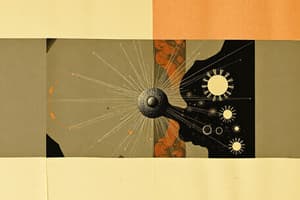Podcast
Questions and Answers
What is the smallest particle of an element?
What is the smallest particle of an element?
An atom
According to the Bohr model, what surrounds the nucleus of an atom?
According to the Bohr model, what surrounds the nucleus of an atom?
Orbiting electrons
What are the two types of particles found in the nucleus of an atom? (Select all that apply)
What are the two types of particles found in the nucleus of an atom? (Select all that apply)
- Neutrons (correct)
- Electrons
- Protons (correct)
What is the basic particle that carries a negative charge?
What is the basic particle that carries a negative charge?
What is the relationship between the atomic number of an atom and the number of protons and electrons in a neutral atom?
What is the relationship between the atomic number of an atom and the number of protons and electrons in a neutral atom?
All atoms of a given element always have the same number of electrons as protons.
All atoms of a given element always have the same number of electrons as protons.
Where can you find the atomic numbers of all the elements?
Where can you find the atomic numbers of all the elements?
Electrons orbit the nucleus at fixed, unchanging distances.
Electrons orbit the nucleus at fixed, unchanging distances.
Electrons closer to the nucleus have higher energy than those further away.
Electrons closer to the nucleus have higher energy than those further away.
What are energy levels known as?
What are energy levels known as?
What limits the maximum number of electrons that can occupy a shell?
What limits the maximum number of electrons that can occupy a shell?
According to the Bohr model, how many electrons and protons are present in a silicon atom?
According to the Bohr model, how many electrons and protons are present in a silicon atom?
The maximum number of electrons (Ne) that can exist in each shell can be calculated by the formula _______, where n is the number of the shell.
The maximum number of electrons (Ne) that can exist in each shell can be calculated by the formula _______, where n is the number of the shell.
Flashcards
Atomic Number
Atomic Number
The number of protons in an atom's nucleus, also equal to the number of electrons in a neutral atom.
Valence Electrons
Valence Electrons
Electrons in the outermost shell of an atom, with the highest energy and easily lost to external sources.
Ionization
Ionization
The process of losing a valence electron, resulting in a positively charged ion.
Electrical Balance
Electrical Balance
Signup and view all the flashcards
Conductor
Conductor
Signup and view all the flashcards
Insulator
Insulator
Signup and view all the flashcards
Semiconductor
Semiconductor
Signup and view all the flashcards
Band Gap
Band Gap
Signup and view all the flashcards
Study Notes
The Bohr Model
- An atom is the smallest particle of an element.
- An atom consists of a central nucleus surrounded by orbiting electrons.
- The nucleus is composed of positively charged protons and uncharged neutrons.
- Electrons are negatively charged particles.
- Each element has a specific number of electrons and protons.
Atomic Number
- The atomic number is the number of protons in the nucleus.
- In a neutral atom, the number of protons equals the number of electrons.
- The net charge of a neutral atom is zero.
- The atomic number is listed on the periodic table.
Electrons and Shells
- Electrons orbit the nucleus at discrete energy levels.
- Electrons closer to the nucleus have lower energy.
- Electron orbits are grouped into shells.
- Each shell has a maximum number of electrons that it can hold.
- Example: Silicon atom has 14 electrons, 14 protons, and 14 neutrons.
Valence Electrons
- Valence electrons are electrons in the outermost shell.
- Valence electrons are less tightly bound to the atom.
- Valence electrons have higher energy.
- Valence electrons can be lost or gained to form ions.
Ionization
- Ionization is the process of gaining or losing valence electrons from an atom.
- When an atom loses an electron, it becomes a positive ion (cation).
- When an atom gains an electron, it becomes a negative ion (anion).
Electrical Balance
- Electrical balance occurs when the number of protons and electrons are equal.
- An imbalance creates a charge.
- Negative charge is produced by many electrons.
- Positive charge is produced by few electrons.
Materials Used in Electronic Devices
- Materials are classified into conductors, semiconductors, and insulators based on their electrical conductivity.
- Conductors easily conduct electricity.
- Insulators do not conduct electricity easily.
- Semiconductors have intermediate conductivity.
Band Gap
- The band gap is the difference in energy between the valence band and the conduction band.
- For insulators, the band gap is large, requiring significant energy for electrons to move to the conduction band.
- For semiconductors, the band gap is smaller, allowing electrons to jump to the conduction band with moderate energy input.
- For conductors, the valence and conduction bands overlap meaning electrons move freely.
Studying That Suits You
Use AI to generate personalized quizzes and flashcards to suit your learning preferences.




